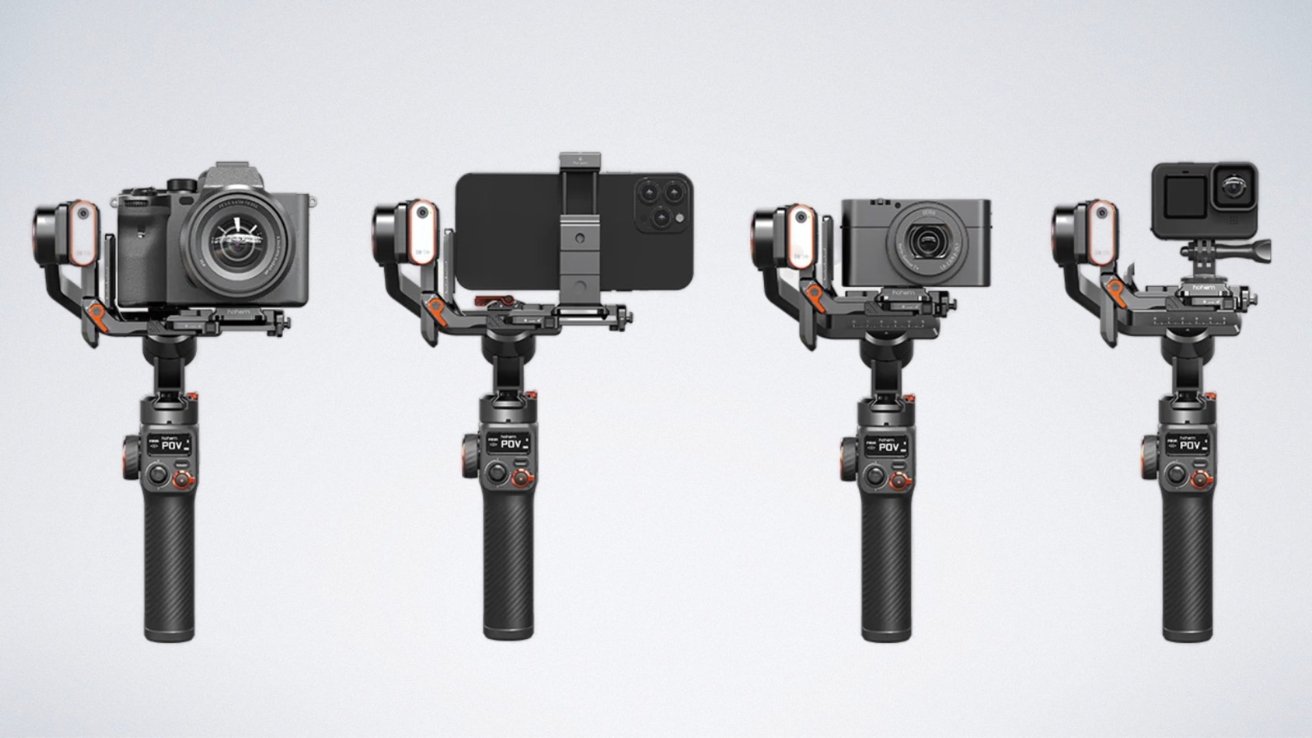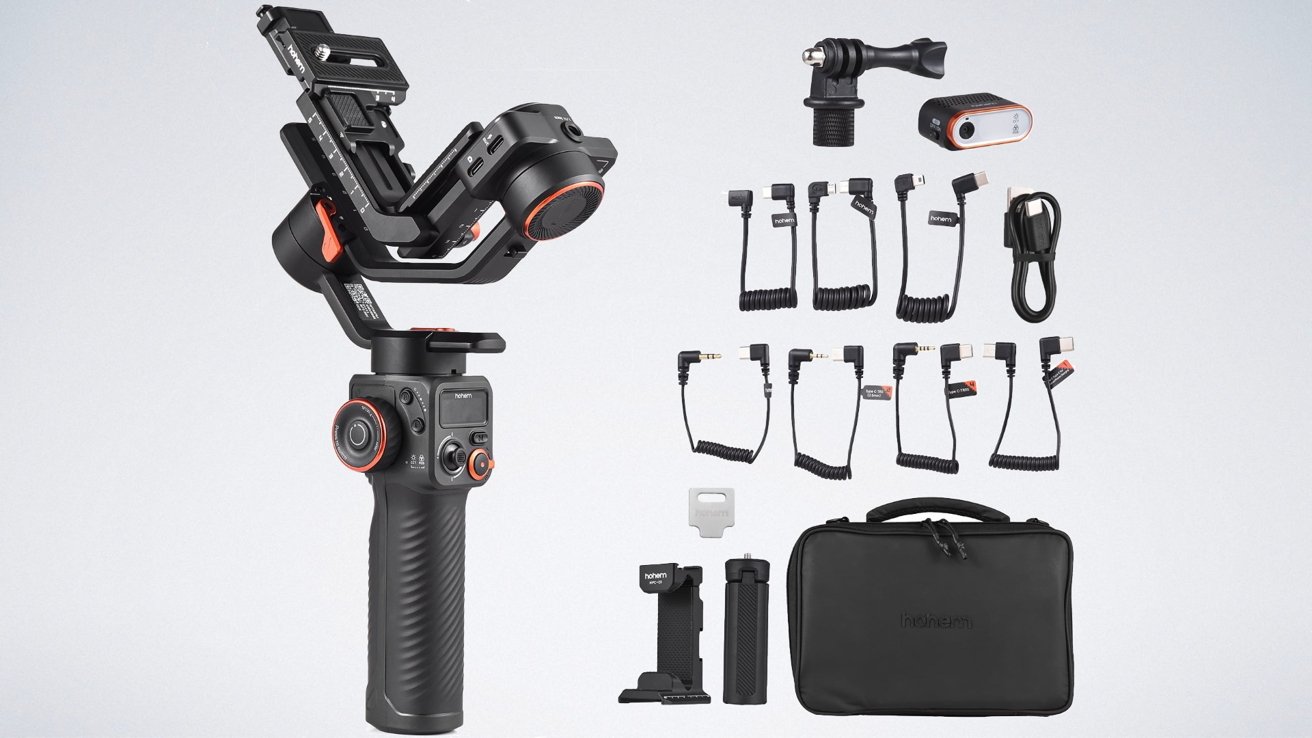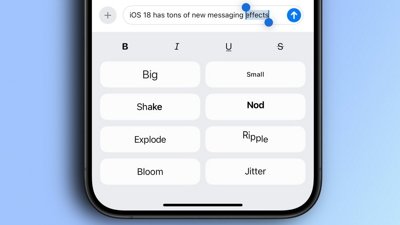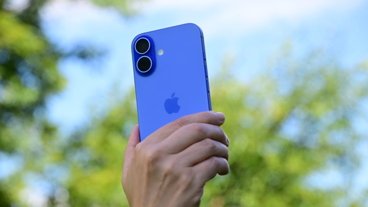If you've ever used a smartphone gimbal before, the Hohem iSteady MT2 is a more solid — and professional-grade — handheld gimbal camera mount that enables smooth motion, AI tracking, and digital control for your iPhone, DSLR, or other cameras.
While both Apple and Android smartphones can take pretty impressive pictures and video, they are by no means a worthy substitute for DSLRs, Superzooms, action cams and other types of cameras. Smartphone gimbals like the DJI Osmo Mobile or the Hohem iSteady V3, which we've previously reviewed, are great for creating smooth videos using smartphones when you or the camera, or both, are in motion.
The Hohem iSteady MT2 is likewise capable of using smartphones for video recording, but is built to handle traditional cameras — and thus is heavier, sturdier, and a more complicated device than a smartphone gimbal. It is a three-axis camera gimbal that can pan, roll, and tilt, all while keeping your expensive camera securely attached.
It also has an attachable — and easy to lose if you're not careful — AI tracking module that, with the help of its included mini-tripod can let the camera follow you by itself. For its price point, it's a great value for intermediate-level or pro videographers.
Getting started
We'd strongly recommend spending some time learning how to mount — and easily unmount — the camera you are going to use, as this takes a little time with DSLRs in particular. Unlike most smartphone gimbals, securing the camera involves an L-bracket, some affixed screws, and quite a number of locking handles and switches to be sure the camera doesn't move in unexpected ways once secured.
Thanks to an array of included extras, if your camera has a Micro USB, Mini USB, USB-A, USB-C, or even a TRS/TRRS connector, cables are included to allow both camera control and reverse charging. The iSteady MT2 can also communicate with some cameras using Bluetooth, as it does to communicate with the smartphone.
First-time users should also take the time to familiarize yourself with the controls via the included paper and online manual, and having a look at Hohem's helpful YouTube videos for any initial questions you might have before heading out. Whether you are using the MT2 with a smartphone or a camera, you will want to get the free Hohem Joy app from the App Store.
Importantly, you should look through the manual or various video reviews before getting started, to learn how to mount and balance your camera in the gimbal. This is crucial to smooth and reliable performance, and if you change cameras, you will want to rebalance the gimbal.
Once you've done this, and reviewed how to control the gimbal's controls and modes, you are ready to take a walkaround with your iSteady MT2. Depending on which parts of the arm are locked or unlocked, you can shoot video in Pan Follow (PF), Pan&Tilt Follow (PTF), All Lock (L) or All Follow (POV).
There are two extra modes: Sports (S) for quick-moving subjects, and Inception (I) mode, named after the visually-innovative film. The latter spins the camera 360 degrees on its pan axis, while the tilt and roll axes are locked.
The kit and kaboodle
Hohem refers to this gimbal package as a kit, which means that unlike most smartphone gimbals, there's more to it than just the gimbal itself. It comes with a lightweight carrying case with room for the needed accessories, including an extendable stand, an "L" bracket, a smartphone mount, various cables for connecting different digital cameras, and more.
It has to be said that Hohem definitely doesn't nickel-and-dime the buyers of the iSteady MT2, unlike some other gimbal makers. Everything you need to get started apart from the camera and some time spent with video or written tutorials is right there in the case.
The gimbal by itself weighs 653g (1.44lbs), and features a built-in 2600mAh battery good for up to 17 hours of use. However, if you are using the included AI tracker and fill light unit, this will reduce the battery time considerably.
The AI Tracker is a clever little unit that allows users to set up the rig on its legs and get into shot themselves. The subject can use hand gestures — detailed in a useful YouTube video — to turn on and off the tracking, or reframe whether they want to be on the left, right, or center of the frame.
One of the only downsides to it is that its magnetic connection to the bracket isn't very strong, making it very easy to pull off accidentally as you try to, for example, remove the lens cover of the camera. The other downside is that the fill light is bright, but doesn't have much throw — making it only good for closeups.
AI tracking and camera control
The Magnetic Fill Light with AI Vision Sensor — which was included in our review kit, but is also available as an optional purchase — can be attached and turned on, and the subject can then control the mode, activate the sensor, and frame themselves within the shot. This allows the camera to follow the subject if they move, and allow them to frame themselves in the center, left, or right side of the shot.
For best results, the subject should be two to five feet away from the camera when making the control gestures. These include the OK gesture to start tracking, open "stop" hand to stop tracking, and the "framing" two-hand gesture to frame or reframe the tracking.
If your camera is on the company's list of supported devices and connected to the gimbal by the control cable, there is a zoom lever and shutter button on the handle facing the operator, and a trigger button where your index finger will naturally be. This also enables the multifunction control wheel on the left side of the handle to be used for focus or roll rotation.
If your camera is one of those models that is unsupported, you can still trigger video recording, zooming, or the shutter button on the camera itself.
Conclusions
Despite its price point on the lower end of handheld camera gimbals, the Hohem iSteady MT2 is not intended for tourist or casual shooters. It takes time to set up and change cameras, time to learn all the controls, and time to lock and unlock parts of the gimbal and master the modes, depending on your camera compatibility.
It can be used more casually if all you want is simple pan, tilt, and roll stabilization — or have an unsupported but fairly lightweight camera. Mounting a smartphone is much less complicated, though still a bit more work than Hohem's dedicated smartphone gimbals like the iSteady V3.
We'd recommend the iSteady MT2 Kit to videographers and YouTubers who want to start doing more outdoor or staged videography that needs the fluidity of movement, particularly for those shooting with action cams or DSLRs. It's also a considerable step up from the cheaper smartphone-only gimbals with its control cable and AI tracking.
One of its standout features is the ability to mount smartphones or cameras either vertically or horizontally with the same quality of control. If you're serious about making Reels for FaceTime and Instagram, or Shorts for YouTube, this gimbal can meet your portrait and landscape shooting needs.
That said, we must emphasize that it takes some time and study to fully master, and the quality materials means it is a bit heavier than casual smartphone gimbal users will be used to. There is an optional "selfie stick" type extender available for higher-angle shots, but that will need still more arm strength to balance.
We hope that the next version of the Magnetic Light and AI Tracker clamps onto the gimbal more firmly — it was always the first thing to dislodge whenever we had to manhandle the camera or iPhone. On one occasion, we watched the module drop 14 floors to the ground — we got it back, completely undamaged, but wouldn't like to repeat that particular stunt.
The iSteady MT2 can serve in a pinch as a poor man's Steadicam, given a compatible camera and taking the time to learn it. We'd recommend Hohem'siSteady V3 smartphone gimbal if you just need something easy and capable for video selfies, walking tours, and other casual uses.
Hohem iSteady MT2 kit pros
- Great price for a handheld camera gimbal
- Included brackets allow for secure vertical or horizontal camera or smartphone mounting
- AI tracker makes tracking and dolly shots easy
- Kit includes lightweight case for the gimbal and all accessories
Hohem iSteady MT2 kit cons
- First-time and previous smartphone-only gimbal users will find initial setup complicated
- USB charger (preferably 5V-2A) not included
- Error codes may appear with no clear explanation of how to resolve them
- Payload weight limitations rule out use of heavy zoom lenses
- Combined weight of camera and gimbal discourages prolonged handheld use
- AI tracker/light unit is easy to disconnect and lose
Rating: 3.5 out of 5
Where to buy the Hohem iSteady MT2 kit
The iSteady MT2 Kit is available directly from the Hohem store for $329, which includes a free bag, remote, or extension pole as a gift with purchase. It's also available from the company on Amazon for the same price with the Magnetic Light and AI Tracker included, or $279 without the tracker. There is also a smartphone-only version that includes the AI tracker for $229.
 Charles Martin
Charles Martin


-m.jpg)






 Malcolm Owen
Malcolm Owen
 Oliver Haslam
Oliver Haslam
 Amber Neely
Amber Neely
 Marko Zivkovic and Mike Wuerthele
Marko Zivkovic and Mike Wuerthele

 Andrew Orr
Andrew Orr











2 Comments
"
There are a dwindling number of use-cases for when an iPhone Pro cannot do an excellent job and for which no gimbal is required due to its stunning image stabilisation (a combination of hardware and software). One is extreme telephoto - 500mm+ (35mm equivalent) - and another is looking like you know what you are doing by using a large camera. One would expect a full-frame DSLR to have better low-light capabilities with a bright (and very expensive) lens but Apple's computational photography approach competes. Shallow depth of field can be achieved computationally too - almost science fiction!
The fact is most DSLRs and mirrorless cameras are used with their kit lenses or other lenses of questionable use relative to the iPhones'. They are like the over-the-shoulder video cameras that Americans carried on using on their holidays for many years after the World had moved on.
I have a full-frame Nikon DSLR but would only use it now with a super-telephoto (Nikkor 500mm) and that kit needs a sturdy tripod, not a gimbal. 99.9% of my use cases are covered by my iPhone 15 Pro Max.
You raise a lot of good points there, Tim, but today's smartphone and DSLR use also incorporates a lot of "walk and talk" videos by YouTubers, and that requires either a really expensive dolly setup -- or a gimbal, so guess which one most YouTubers would go for. I've used gimbals with smartphones mounted out of a car following someone running for shots about their training, and again for "walk around them" shots while sparring with partners in a boxing ring.
You're right that iPhones have fantastic image stabilization these days, but sometimes either you are in motion (hanging out of a jeep shooting wildlife in Africa) or the subject is in motion, and a gimbal is yet another great tool (and reasonably compact to bring with you) for those circumstances.